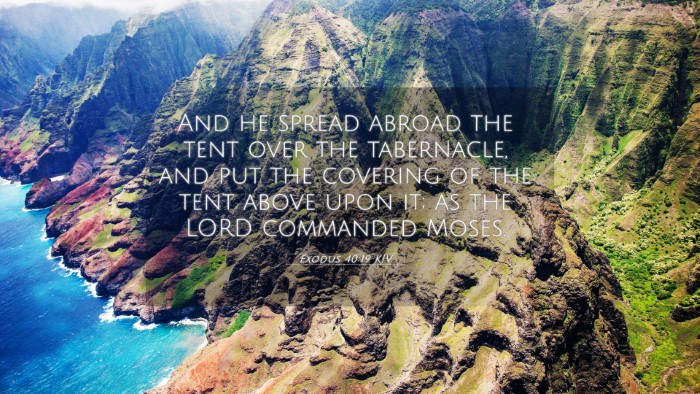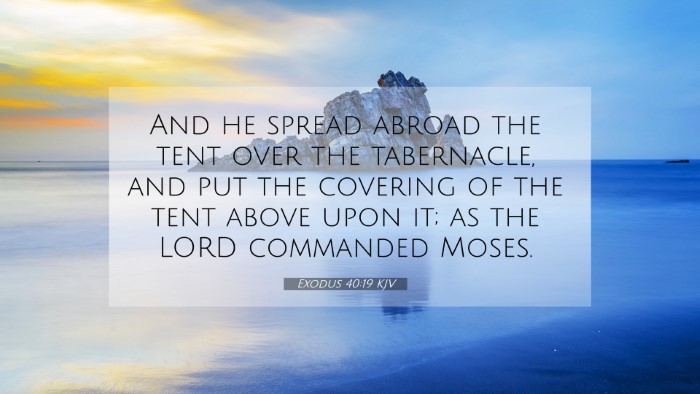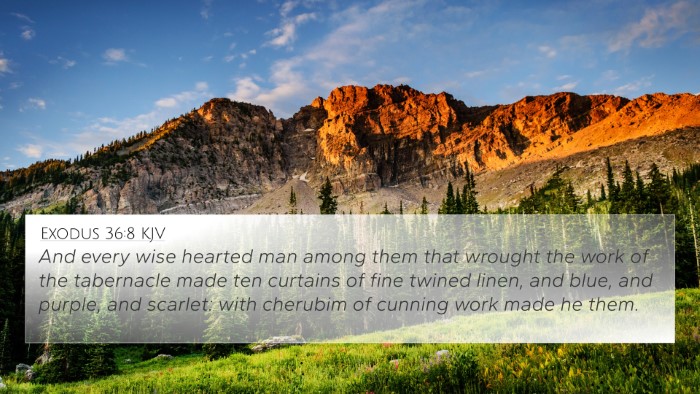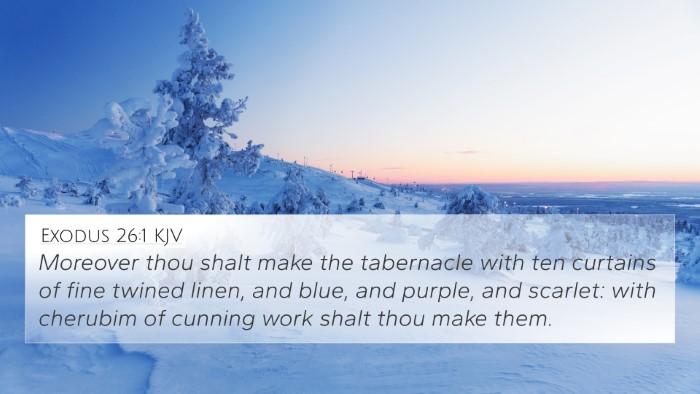Understanding Exodus 40:19
Exodus 40:19 states: "And he spread abroad the tent over the tabernacle, and put the covering of the tent upon it; as the Lord commanded Moses." This verse signifies the fulfillment of God's specific instructions regarding the construction and setup of the Tabernacle, a central component of Hebrew worship and a physical manifestation of God's presence among His people.
Interpretation and Meaning
The interpretation of this verse reflects adherence to divine command and the importance of obedience in the life of the believer. The Tabernacle represented not only a place of worship but also served as a symbol of God dwelling among His people. According to Matthew Henry, this act of spreading the tent highlights Moses' meticulousness in ensuring that God's will was perfectly executed. The way the coverings are applied emphasizes the reverence and care that the leader had towards the sacred.
Albert Barnes further elaborates that the Tabernacle's coverings were practical and symbolic. The careful arrangement of these elements reflects the necessary separation of the holy from the unholy, reinforcing the idea of reverence due to God's dwelling place. Adam Clarke adds that this detailed account also serves as a testament to God's glory and the seriousness with which He regards the places set apart for worship.
Key Themes
- The Obedience to God's Instructions: Moses's action was a direct compliance with God's commandments, exemplifying the broader theme of obedience that runs throughout the Scriptures.
- The Presence of God: The Tabernacle was not only a physical structure but a crucial representation of God's presence among His people, a theme that resonates through various parts of the Bible.
- Holiness and Separation: The coverings symbolize the protection and holiness associated with God's dwelling, reinforcing the essential separation from the sinful world.
Bible Cross-References
This verse is intricately linked with several other scriptures that enhance its meaning and context, revealing the thematic connections woven throughout the Bible. Here are some notable cross-references:
- Exodus 25:8-9: "And let them make me a sanctuary; that I may dwell among them. According to all that I show thee, after the pattern of the tabernacle, and the pattern of all the instruments thereof, even so shall ye make it." This verse establishes the intent behind the Tabernacle's existence.
- Leviticus 26:11-12: "And I set my tabernacle among you: and my soul shall not abhor you. And I will walk among you, and will be your God, and ye shall be my people." This reinforces the significance of God's dwelling among His people.
- Hebrews 9:1-5: "Then verily the first covenant had also ordinances of divine service, and a worldly sanctuary. For there was a tabernacle made; the first, wherein was the candlestick, and the table, and the shewbread; which is called the sanctuary." Here, the Tabernacle is viewed through the lens of New Testament theology, reflecting its significance in the plan of salvation.
- 1 Chronicles 28:11-12: "Then David gave to Solomon his son the pattern of the porch, and of the houses thereof, and of the treasuries thereof, and of the upper chambers thereof, and of the inner parlours thereof, and of the place of the mercy seat." This relates to the continuity of God’s dwelling through the ages.
- John 1:14: "And the Word was made flesh, and dwelt among us, (and we beheld his glory, the glory as of the only begotten of the Father,) full of grace and truth." This verse connects the concept of God's dwelling to Jesus Christ in the New Testament.
- Matthew 17:5: "While he yet spake, behold, a bright cloud overshadowed them: and behold a voice out of the cloud, which said, This is my beloved Son, in whom I am well pleased; hear ye him." This shows that Jesus is the ultimate fulfillment of where God dwells with humanity.
- Revelation 21:3: "And I heard a great voice out of heaven saying, Behold, the tabernacle of God is with men, and he will dwell with them, and they shall be his people, and God himself shall be with them, and be their God." This reiterates the eternal aspect of God’s dwelling among His people.
Connections Between Bible Verses
The connections between these verses form a rich tapestry that reveals God's consistent theme of seeking to dwell among humanity throughout the Scriptures. The Tabernacle, as noted in Exodus and reinforced by other cross-references, acts as a bridge linking Old Testament sacrificial system to Christ's ultimate sacrifice and God's promise of eternal fellowship with His people.
Tools for Bible Cross-Referencing
For those looking to delve deeper into the connections within the Bible, various tools can enhance the study:
- Bible Concordance: A handy tool for finding verses related to specific words or themes, facilitating deeper study.
- Bible Cross-Reference Guide: Guides that can help identify thematic links between different scriptures.
- Cross-reference Bible Study: Techniques that encourage connecting verses that illuminate deeper spiritual meanings.
- Bible Reference Resources: Tools that aid in identifying connections between scriptures across different books.
Conclusion
Exodus 40:19 serves as a significant verse highlighting the faithfulness of Moses in executing God's command to construct the Tabernacle. Through understanding this verse and its cross-references, one can grasp the depth of God's desire to dwell with humanity, the importance of obedience, and thematic continuity across the Bible. The scriptural cross-referencing provides a rich field for study and understanding, helping believers connect the dots between various parts of Scripture and reveal God's unfailing presence throughout history.




